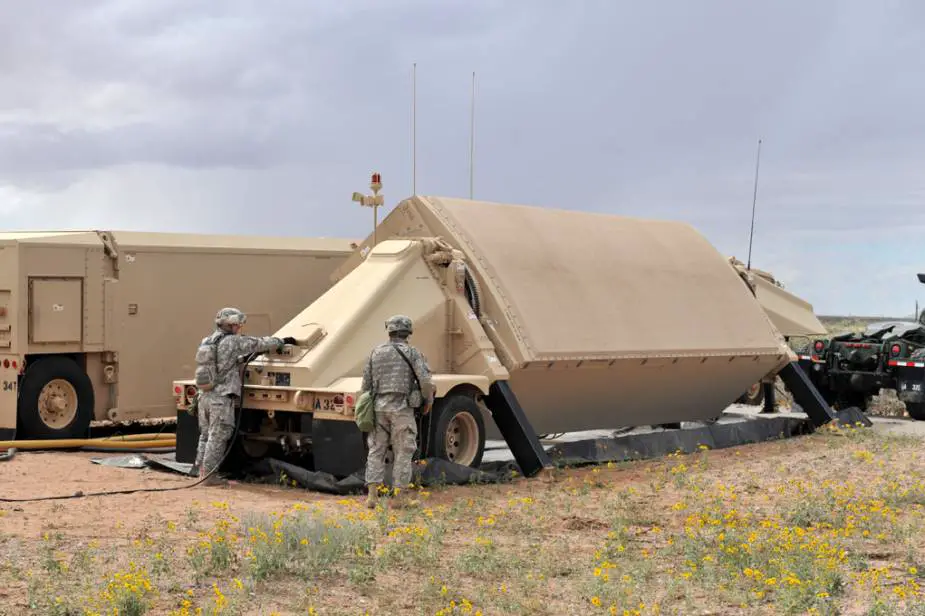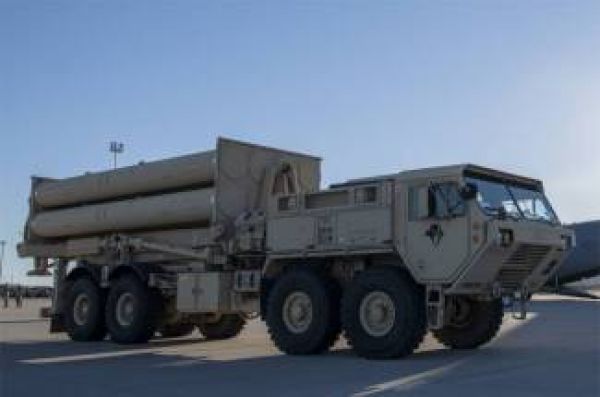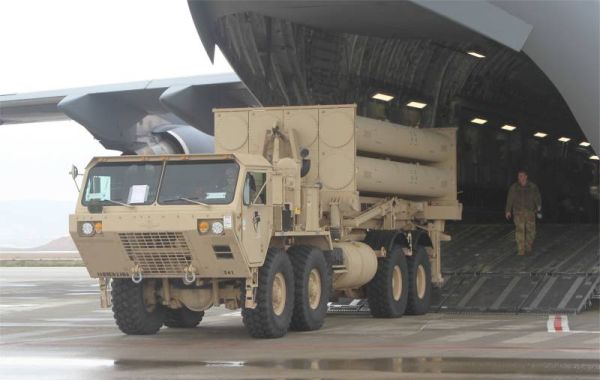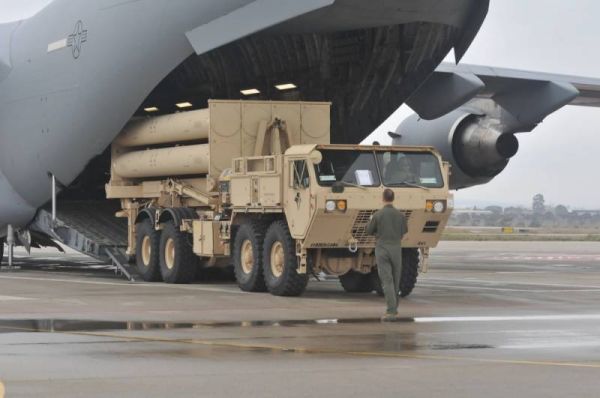Air Defense Vehicles.
THAAD.

The THAAD (Terminal High Altitude Area Defense) missile system is an easily transportable defensive weapon system to protect against hostile incoming threats such as tactical and theatre ballistic missiles at ranges of 200 km and at altitudes up to 150 km.
Country users : United States, Saudi Arabia, United Arab Emirates
Description
The Terminal High Altitude Area Defense (THAAD) is a key element of the Ballistic Missile Defense System (BMDS) designed to defend U.S. troops, allied forces, population centers, and critical infrastructure. THAAD operates in a unique battle space intercepting both endo- and exo-atmospheric short-to-intermediate range ballistic missiles. This ground-based missile defense system is rapidly deployable with high mobility, providing proven capability to Combatant Commanders worldwide. THAAD is an interoperable system with other BMDS elements and can accept cues from Aegis, satellites and other external sensors, as well as work in concert with the Patriot/PAC-3. The THAAD (theatre high-altitude area defense) missile system is an easily transportable defensive weapon system to protect against hostile incoming threats such as tactical and theatre ballistic missiles at ranges of 200 km and at altitudes up to 150 km. In December 2011, THAAD delivered its 24th interceptor, completing the first THAAD Battery (A-4 ADA). Two THAAD batteries have been activated at Fort Bliss, Texas. The first THAAD Battery (A-4 ADA Battery) was activated in May 2008. The second THAAD Battery (A-2 ADA Battery) was activated in October 2009. The Army anticipates activating the third Battery in late 2012. In March 2012, Lockheed Martin completed the delivery of all hardware and components associated with the Terminal High Altitude Area Defense (THAAD) weapon system’s first U.S. Army Battery. There are 4 THAAD batteries that will be sold to the United Arab Emirates (UAE) and Taiwan, this extended production will lower THAAD production costs. Five batteries are on order by Germany, Israel, South Korea, and Japan. The United Arab Emirates signed a deal to purchase the missile defense system on 25 December 2011 The US Defense Security Cooperation Agency notified Congress on November 2, 2012, of a possible Foreign Military Sale to the Government of Qatar for two Terminal High Altitude Area Defense (THAAD) Fire Units and associated equipment, parts, training and logistical support for an estimated cost of $6.5 billion. On 1 April 2019, the U.S. Department of Defense has announced that Lockheed Martin Corp. Missiles and Fire Control, Dallas, Texas, is being awarded a $2,457,390,566 modification (P00015) to a previously-awarded contract HQ0147-17-C-0032 for the production of Terminal High Altitude Area Defense (THAAD) interceptors and associated one-shot devices to support the U.S. government (USG) and the Kingdom of Saudi Arabia (KSA) Foreign Military Sales (FMS) case requirements. The United Arab Emirates signed a deal to purchase the missile defense system on 25 December 2011. The United Arab Emirates (UAE) graduated its first two THAAD unit classes at Fort Bliss in 2015 and 2016. On 6 October 2017, the US reached a deal to provide Saudi Arabia with THAAD in a deal worth $15 billion, including seven fire units each with a Raytheon AN/TPY-2 radar, two mobile tactical stations (with two spares for a total of 16), and six launchers (with two spares for a total of 44), 360 interceptor missiles. In March 2022, Germany requested new weapons and military equipment from the United States including the THAAD Terminal High Altitude Area Defense, an air defense missile system. On August 2, 2022, the US approved the sale of ninety-six THAAD missile rounds, two THAAD Launch Control Stations (LCS), and two THAAD Tactical Operations Stations (TOS). According to information published in 2023 by the SIPRI arms trade database, the United States is set to deliver seven THAAD air defense missile systems and 360 THAAD missiles to Saudi Arabia.
THAAD variants:
- No variants at this time
Technical Data
-
Missile
The THAAD missile is 6.17 m in length and is equipped with a single-stage solid-fuel rocket motor with thrust vectoring. The rocket motor is supplied by Pratt & Whitney Rocketdyne. The launch weight is 900 kg. The target object data and the predicted intercept point are downloaded to the missile prior to launch. The updated target and intercept data are also transmitted to the missile in flight. The THAAD missile can destroy aerial targets at ranges from 150 to 200 km and can reach a maximum altitude of 150 km. Unlike other missile defense systems, THAAD can intercept targets within (endoatmospheric) and outside (exoatmospheric) the atmosphere.
-
Main Features
• Defends against short-, medium- and intermediate-range ballistic missiles
• Unique endo- and exo-atmospheric intercept capability
• Dedicated to BMD missions – always optimally positioned to counter the prevailing threat
• Interoperable with other Ballistic Missile Defense (BMD) systems
• High lethality with proven hit-to-kill
• High firepower and sustainability for resistance to mass attack
• High single-shot kill probability provides cost-effectiveness -
Launcher Vehicle
THAAD launcher unit vehicle is a modified Oshkosh Truck Corporation Heavy Expanded Mobility Tactical Truck with Load Handling System (HEMTT-LHS). The 12m-long by 3.25m-wide launch vehicle carries eight missile launch containers. While on the launcher, lead-acid batteries provide the primary power. The batteries are recharged with a low-noise generator.
-
Battery Components
A THAAD battery consists of four main components including up to 9 mobile launcher vehicles with eight missiles ready to fire, one AN/TPY-2 surveillance X-band radar used to search, track, and discriminate objects and provides data to the interceptor and fire control and command vehicle that links THAAD components together, and plans and executes intercept solutions.

The THAAD Radar is an X-Band Radar developed and built by Raytheon at its Andover, Massachusetts Integrated Air Defense Facility. It is the world's largest ground/air-transportable X-Band radar. The THAAD Radar and a variant developed as a forward sensor for ICBM missile defense, the "Forward-Based X-Band - Transportable (FBX-T)" radar were assigned a common designator, AN/TPY-2, in late 2006/early 2007. The AN/TPY-2 radar uses a 9.2m² aperture full field of view antenna phased array operating at I and J bands (X-band) and contains 25,344 solid-state microwave transmit and receive modules. The radar has the capability to acquire missile threats at ranges up to 1,000km.
The THAAD Fire Control and Communications (TFCC) component oversees battery operations and relays fire control information to other elements of the joint force. Each system, known as a Tactical Station Group (TSG), incorporates a Tactical Operations Station (TOS) with two operating stations, a Launch Control Station (LCS), which includes wireless datalinks, networking equipment, and fiber optic cable interfaces, and a Station Support Group (SSG) which includes HMMWV-based antenna and cable support vehicles. -
Combat Use
The Terminal High Altitude Area Defense (THAAD) element provides the Ballistic Missile Defense System (BMDS) with a globally-transportable, rapidly-deployable capability to intercept and destroy ballistic missiles inside or outside the atmosphere during their final, or terminal, phase of flight. The THAAD missile is capable of shooting down a ballistic missile both inside and just outside the atmosphere. The missile is highly effective against ballistic missile threats and uses hit-to-kill technology whereby kinetic energy destroys the incoming warhead. The high-altitude intercept mitigates the effects of enemy weapons of mass destruction before they reach the ground.
Specifications
-
Type
Long-range Surface-to-Air Missile
-
Country users
United States, Saudi Arabia, United Arab Emirates
-
Designer Country
United Staes
-
Deployment Time
Eight hours
-
Radar Detection Range
870 m to 3,000 km
-
Number of missiles
Eight missiles by truck launcher unit
-
Range missile
150 to 200 km
-
Altitude missile
150 km
-
Guidance missile
Indium-antimonide imaging infra-red seeker head
-
Battery Components
Radar Surveillance (AN/TPY-2), Communications and data-management vehicle














































